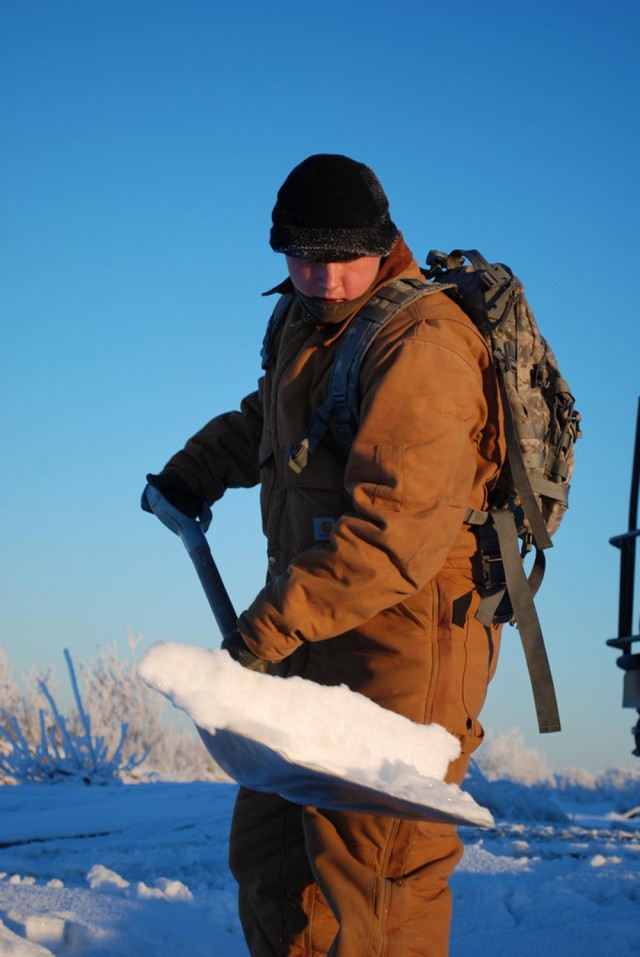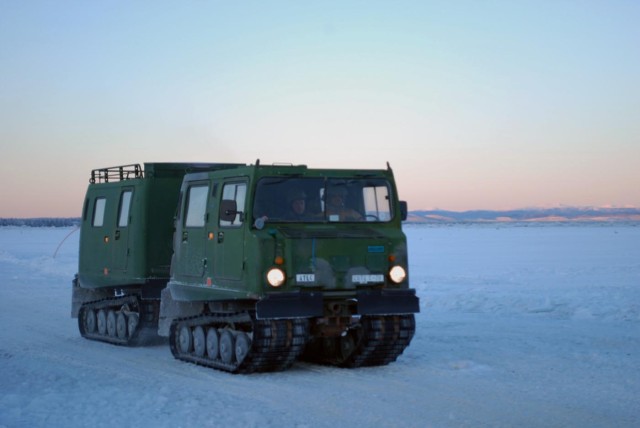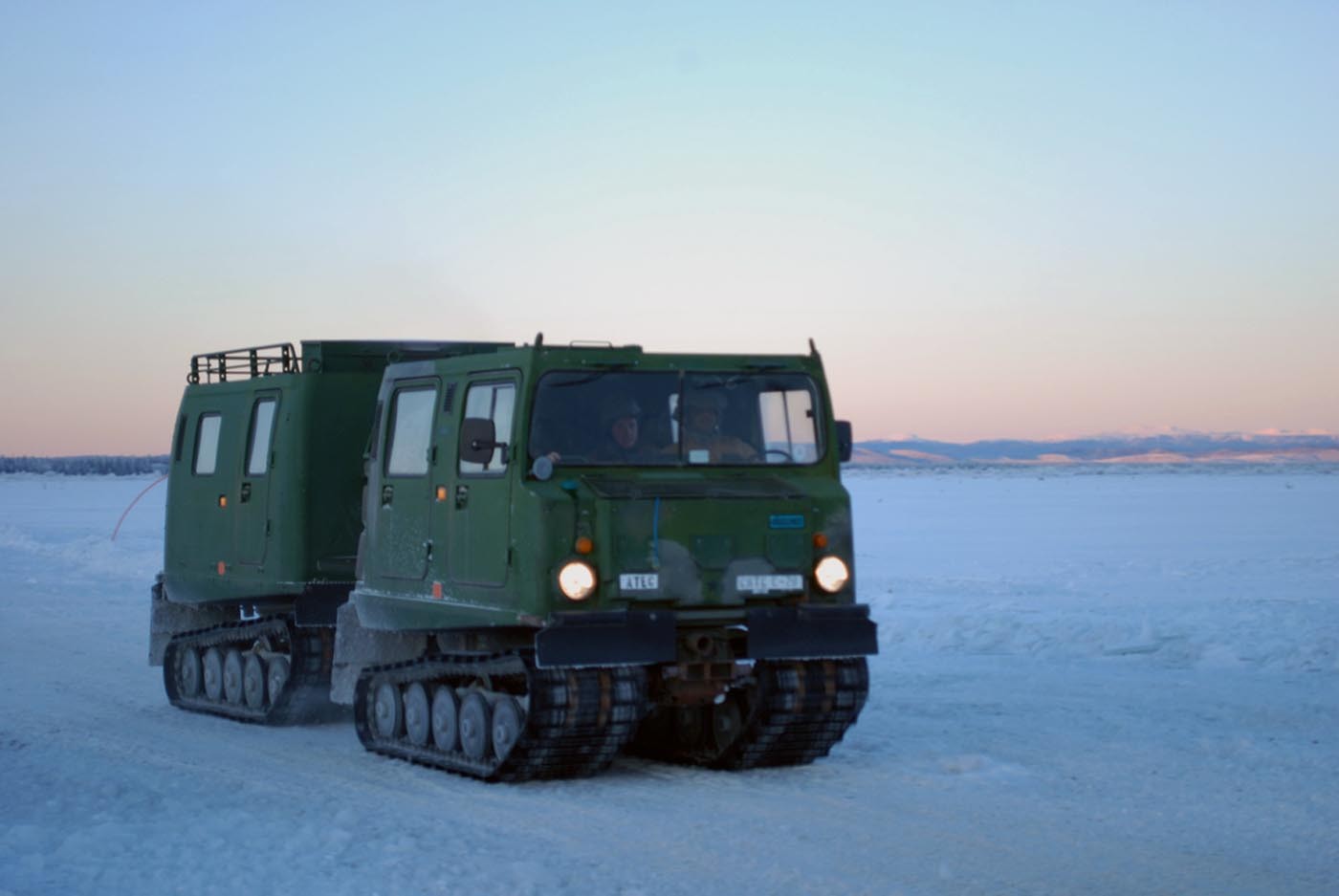JOINT BASE ELMENDORF-RICHARDSON, Alaska - The ice bridge at the U.S. Army Cold Regions Test Center at Fort Greely, about 100 miles southeast of Fairbanks, enables units to reach otherwise inaccessible areas across the frozen Delta River.
It also gives the Soldiers of the 6th Engineer Battalion at Joint Base Elmendorf-Richardson an opportunity to learn special skills and receive hands-on training they could not get anywhere else.
The training was a brand-new experience for most of the 19 Soldiers from the 6th Engineer Battalion. For some, it was not even a task in their job descriptions, with career fields ranging from equipment operators to construction workers and even a medic.
The Soldiers had to wear headlamps to see in the mid-winter darkness of interior Alaska. They started the job with hand-held augers to drill into the ice to find unfrozen water in the riverbeds which they would use elsewhere to build the ice bridge, according to 1st Lt. Collin Russell, 56th
Engineer Company, 6th Engineer Battalion.
They pumped the water to other areas where it would freeze solid enough to form the bridge. With the temperatures below zero, it only takes minutes to freeze the 2- to 4-inch pools of water.
While engineer field manuals have instructions for ice bridges, this one was different, according to Russell.
Standard ice bridges involve building with blocks of ice then using water to freeze them together, Russell said. The 6th Engineer bridge used its environment for support, due to the extreme cold temperatures ranging from 5 degrees to 25 degrees below zero. Because the bridge spans a "braided" river (made up of small channels) it's easier and more efficient if the engineers use the natural elements to their advantage.
Spc. Mark E. Chumley, a heavy equipment operator with the 56th Engineer Company, said he re-enlisted while on deployment to come to Alaska and had just arrived in September.
He said he asked to stay for the duration of the mission, to experience building the ice bridge by hand and doing what he does best as an equipment operator: driving across it - in vehicles weighing as many as 56 tons.
The minus 24 degree temperatures had not frozen Chumley's spirits.
"I love my job," he said, looking down at his gloves and coveralls, soaked from his knees down after fixing a partially frozen water line. "And as you can tell," he said, "I get into it."
He headed to the warming hut for some dry clothing and would be back out doing it all again in no time.
The engineers built field-expedient water tanks, berms of snow and crushed ice, to keep the water in designated areas for freezing. They move about 70,000 gallons of water per day using a gas-powered water pump and water lines. Once the bridge is capable of holding the weight, they will use 5,000 gallon water trucks to help speed up the process by delivering water faster than the pump.
On their first day at the site, there was no snow on the ice to build the berms, according to Spc. Ammon K. Miller, 56th Engineer Co. He said they did what they could with hand tools and vehicles to crush ice for until the third day when it snowed.
Every time a new section of the bridge needed a new layer of ice, new berms had to be created.
Miller said everyone did their assigned jobs and that he liked being there.
He joked that the only thing that was "a little awkward" was when their medic, Pfc. Jason Woolard, of Headquarters and Headquarters Company, 6th Engineer Batallion, would come by and check on them for cold weather injuries. "He just comes by and grabs your nose," Miller said with a grin.
Even though Woolard is a medic, he was doing all the same manual labor with the rest of the Soldiers, along with making rounds about every 30 minutes to check for injuries. To date, there have been no injuries, even after a week of non-stop work.
"These guys work their butts off, then we all go home and pass out," Russell joked.
The team worked from 7 a.m. until about 4 p.m. and put their equipment in storage so it wouldn't freeze. The next day they take it all back out and start again.
Even though not everyone currently working on the ice bridge will remain until it is complete, there will still be personnel on site to monitor and maintain the bridge and to control access points, making sure the bridge doesn't get overloaded, according to Russell.
The ice bridge will slightly longer than a mile. It will be 24 inches thick and 75 feet wide. The bridge will grow and expand naturally with the weather changes, requiring some personnel to stay longer to maintain it.
The project is scheduled to be complete by Feb. 25.
Russell said he and a few others will stay until completion. He called the experience "the best thing I've done," and that there has been a real sense of camaraderie among the troops.
For photos of the ice bridge construction see:
http://www.flickr.com/photos/usarak/sets/72157625728487993/






Social Sharing